Costa Rica’s protected forests are the heart of its environmental splendor. But the country’s network of national parks don’t do it alone. Dozens of private reserves combine to safeguard an enormous amount of additional land. Many times, these reserves not only preserve, but also restore, the forests. One such place is the Madre Verde Nature Reserve in Palmares. In this post, we’ll share more about this inspiring reserve, including its hiking trails, gardens, and the wildlife we saw on a recent visit.
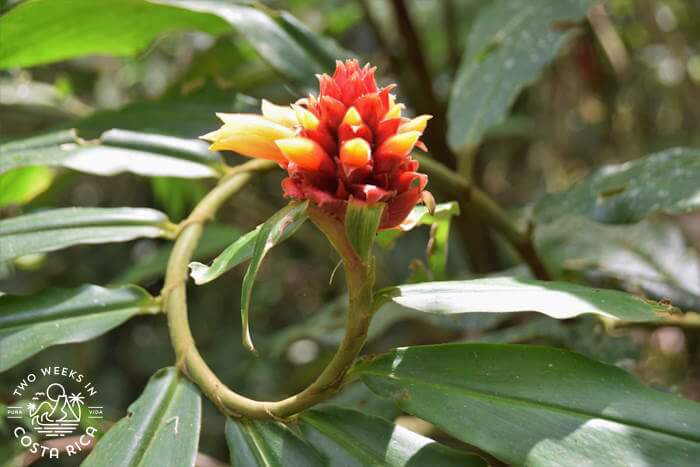
Background and Location
Madre Verde Nature Reserve (Reserva Natural Madre Verde) is a 31 hectare (76 acre) protected area in the town of Palmares. Palmares is a local town with a history of farming and furniture making. It is located approximately 45 minutes west of SJO International Airport. The closest city is San Ramon.
Madre Verde Nature Reserve protects land in the southeastern corner of a larger conservation area called the Montes del Aguacate Biological Corridor. This swath of connected forests stretches from Palmares, through San Ramon, and ends at the slope of the Monteverde cloud forest.
The nature reserve is managed by the Madre Verde Foundation, which is a non-profit organization that also does environmental work in the community.
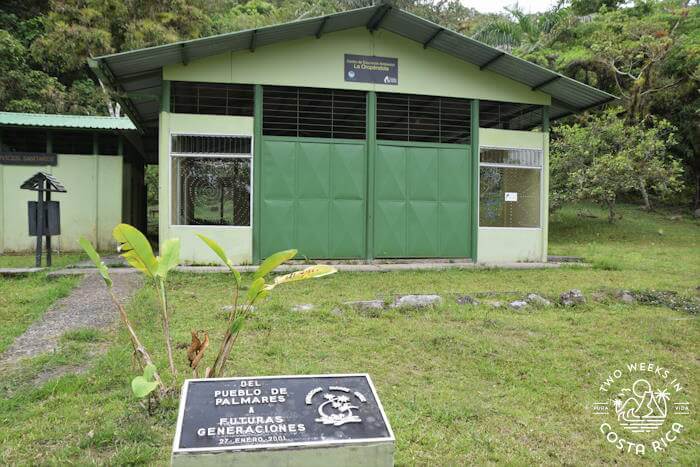
History
Walking the trails at Madre Verde, you would probably not realize that just a short time ago, the land looked very different.
Previously, it was a mixed area of forest and vast dairy pasture. Soon after becoming a nature reserve, pioneering tree species began to grow. These aggressive and fast-growing plants became the foundation for the thick secondary forest you can see today.
The Madre Verde Foundation has carefully monitored and nurtured the reserve’s regrowth for more than 20 years.
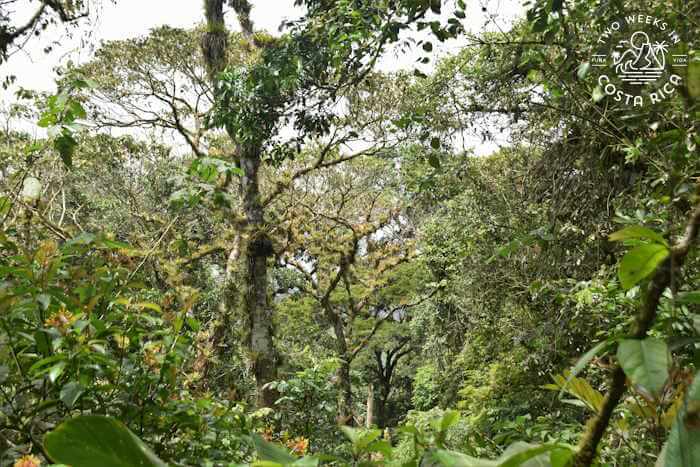
Hiking Trails
At Madre Verde, you’ll find four hiking trails. These begin from the welcome office at the base of a big hill. After paying the entrance fee, you can hike up and around the mountain, making a nice loop.
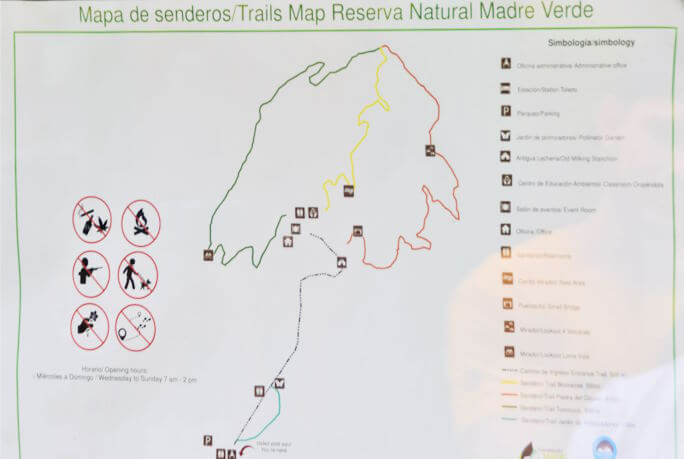
Trail Conditions
The trails at Madre Verde are dirt and gravel. The foundation has done work to create steps and railings in steeper areas.
Overall, the trails are easy to moderate in difficulty. We did them with our two young boys (ages 4 & 7 at the time). The trails are well maintained overall, but there are some rocks and roots along the way.
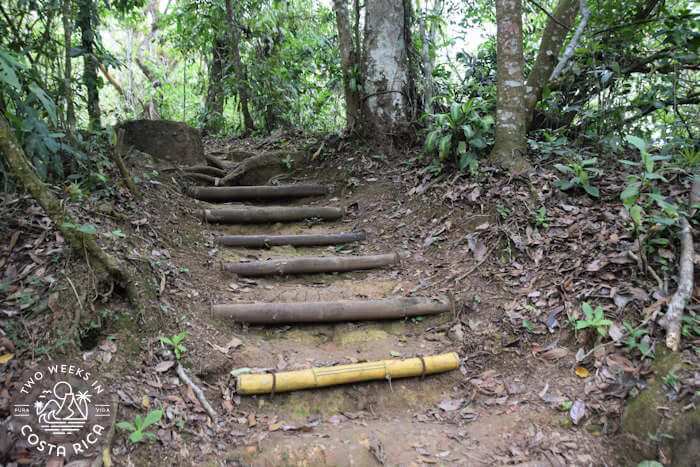
We spent a few hours here. During that time, we were able to cover most of the reserve’s trails and have time for a short picnic.
Pollinator Garden Trail (Sendero Jardin de Polinizadores)
Just past the entrance gate is the Pollinator Garden Trail. From the steep access road, it starts on the right. This short trail is only 135 meters long (443 feet). It arcs back to the access road, passing some bamboo and flowering shrubs.
At the end of this trail, you can visit a pollinator garden. This area has been planted to attract bees, butterflies, and other insects. They even have a small bee house made of old sticks and wood.
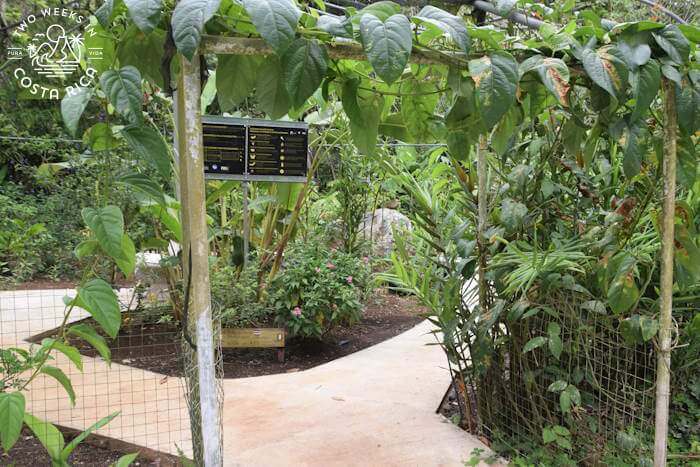
The pollinator garden has a nice paved pathway that is handicap accessible. There are a couple of resting benches as well. We saw a lot of cool insects here.
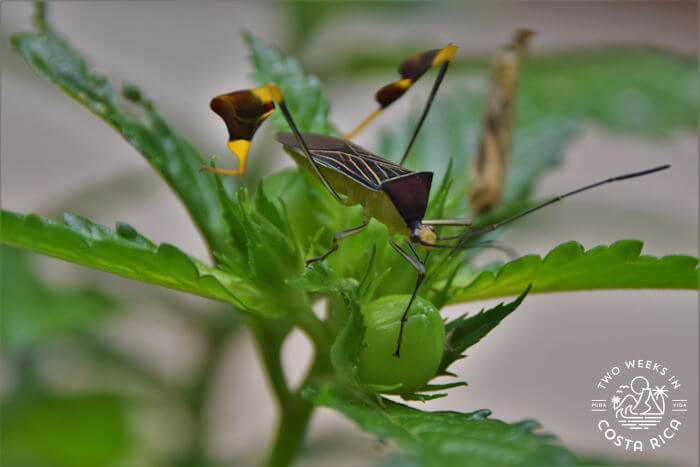
Coyote Stone Trail (Sendero la Piedra del Coyote)
After climbing the access road for another five or 10 minutes, you will arrive at an open area with some buildings. This is where many local families come to picnic on weekends and holidays (more below).
From the picnic area continuing to the right, you will see the entrance to the Stone of the Coyote Trail. This trail is around 915 meters (0.57 miles) and zigzags up the mountainside to a higher point on the property.
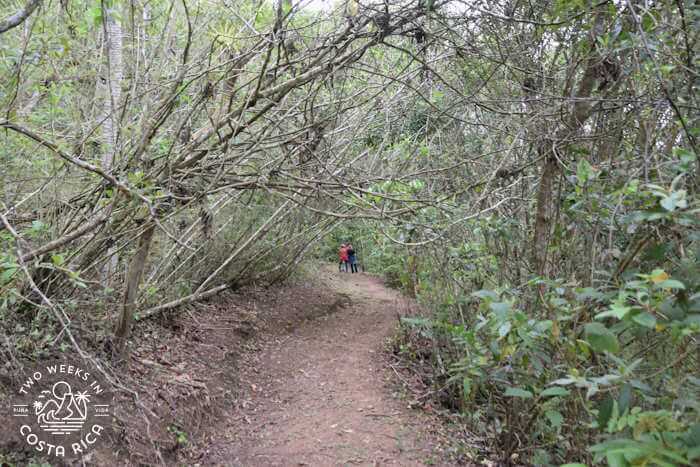
Volcano Lookout
About halfway up the Coyote Stone Trail is a lookout with resting benches. Here, on a clear day you can see four volcanoes in Costa Rica’s Central Volcanic Range. These include Poas Volcano, Barva Volcano, Irazu Volcano, and Turrialba Volcano.
Unfortunately, it was cloudy the day we visited so the views weren’t great.
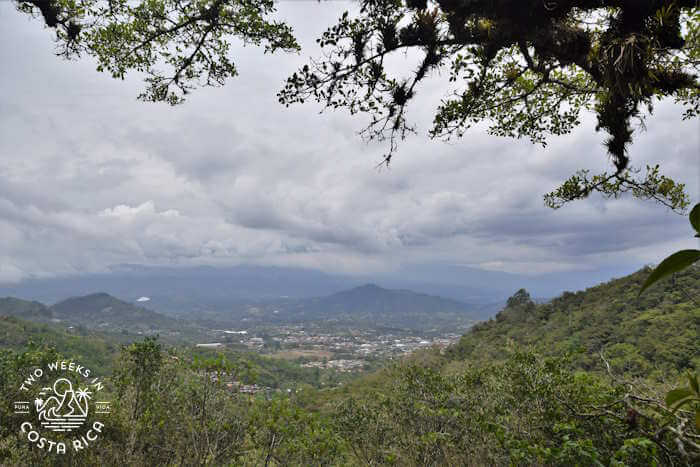
Bromeliad Trail (Sendero Las Bromelias)
At the end of the Coyote Stone Trail, you will arrive at an intersection. To the left is the Bromeliad Trail. This 550-meter (0.34 mile) trail heads back down the hill, through the forest, and to the picnic area.
We didn’t take this trail because we continued up the mountain on the Tolomuco Trail. We did, however, see a cool hive of stingless bees at the intersection.
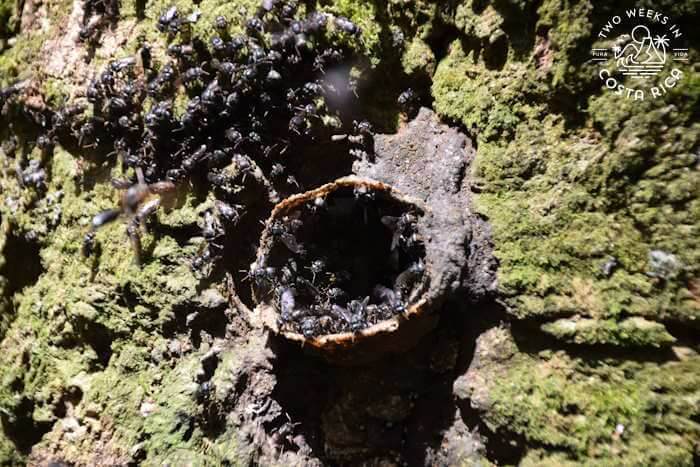
Tolomuco Trail
At the end of the Coyote Stone Trail, you also can continue onto the Tolomuco Trail. This 900-meter (0.56 mile) trail goes uphill to the top of the property before meandering back down to the picnic area.
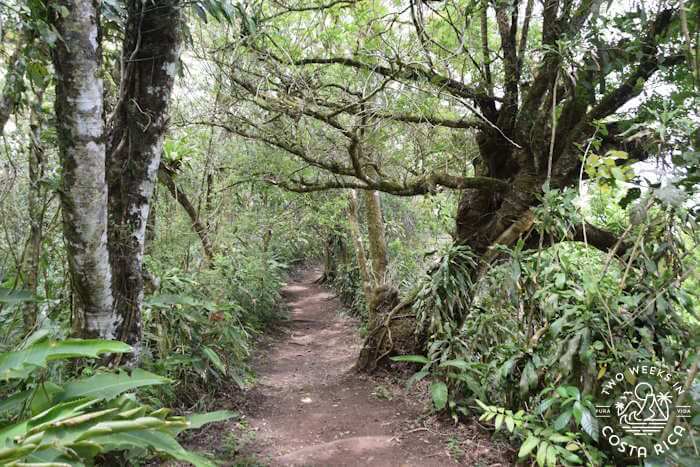
The Tolomuco Trail is named after a sleek weasel-like animal (called tayra in English). The tayra is found in Costa Rica and within the reserve. These quick, elusive mammals have black fur and are sometimes seen streaking across trails and fields.
On the descent down this trail, there is also a notable viewpoint.
Life Hill Lookout (Mirador Loma Vida)
From the Life Hill Lookout, you will have a nice view of Palmares with Cerro Espíritu Santo (Hill of the Holy Spirit) in the background.
Cerro Espíritu Santo is one of the tallest points in the area and has an interesting history. Legends say that the volcanically formed hill would erupt someday and devastate the coffee fields and farms.
To put the locals’ minds at ease, in 1916 a nearby parish began to build a religious monument at the top. The monument was never finished but the hill still became a well-known religious site and is visited often.
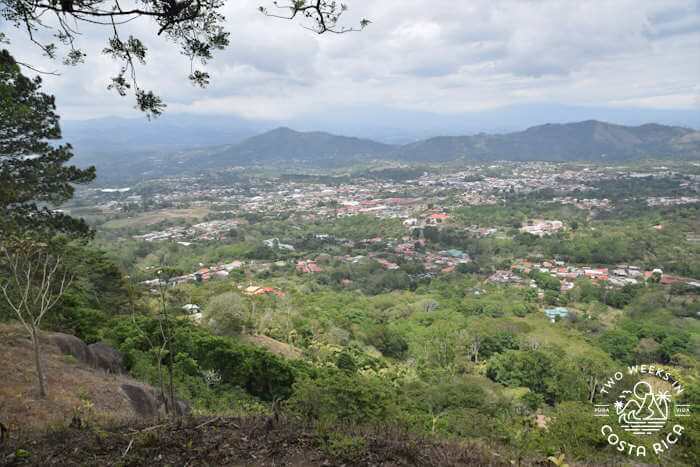
Wildlife
As the forest has regrown at the Madre Verde Reserve, the wildlife has returned as well. The foundation does wildlife monitoring to identify bird, mammal, and insect species.
Some of the interesting wildlife they have seen include coyotes, possums, racoons, monkeys, tayras, and coatis (a racoon-like animal).
During our visit, we didn’t see any mammals, but we did see and hear many birds. Some that we were able to identify include the Brown Jay, Montezuma Oropendola, Little Tinamou, Canada Warbler, and Long-tailed Manakin.
The Long-tailed Manakin is a special bird with two wispy tail pieces. These small birds are mostly black with a little blue and red. They hop around on low branches and are somewhat hard to find.
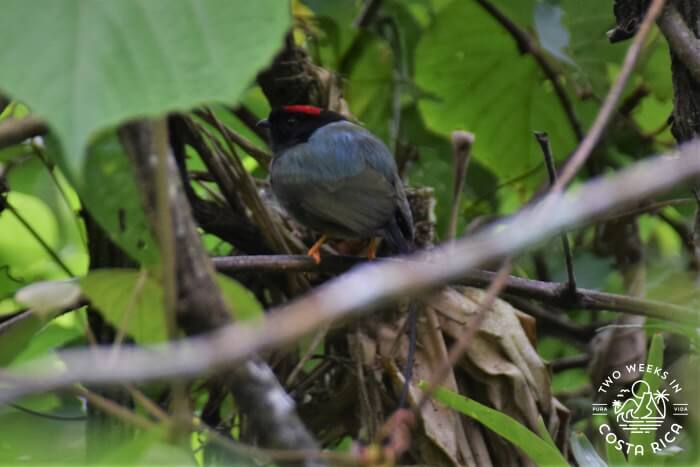
We also spotted a non-venomous snake near the end of the Tolomuco Trail. Based on the quick glimpse we got, we identified it as a speckled racer.
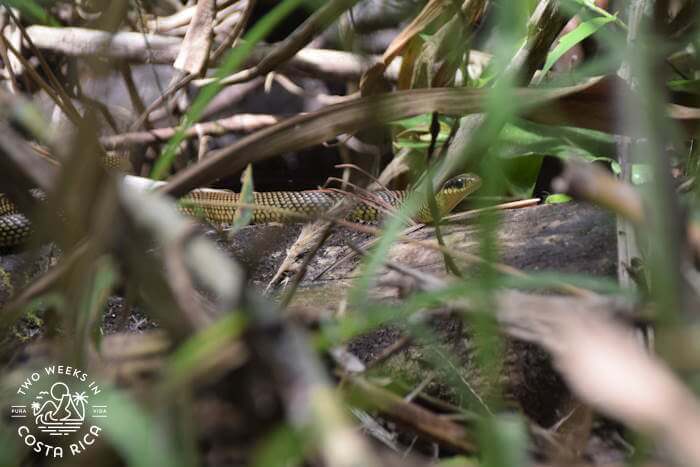
Picnic Area
Where the three trails (Coyote, Bromeliad, and Tolomuco) start/end is the large green area. Here, there are some picnic tables, restrooms, and a small playground. They also have a building for environmental education events and classes.
Another interesting building in the green space is the old dairy barn, which still has a stable intact.
Planning Your Visit
Hours
Madre Verde Nature Reserve is open Wednesday through Monday (closed Tuesday) from 7:00 a.m. to 4:00 p.m.
Cost
To enter the reserve, the foundation asks for a donation of 1,000 colones (about $2) per person. We recommend more if you can. They will put the money to good use with their important programs and maintenance.
Gift Shop
Inside the office is a small gift shop with shirts, hats, travel mugs, and more. We picked up some cool shirts for the kids that had some of the local wildlife. During our visit, they also had local honey for sale.
Parking
Free parking is available and fairly secure because it is right next to the reserve’s office.
What to Wear/Bring
We would recommend bringing a small day pack with all the food and water you will need for the day.
For the hiking trails, it is best to have closed-toed, good-gripping sneakers or hiking boots. Shorts or lightweight hiking pants are fine.
Temperatures in Palmares are generally warm during the day in the high 70s or 80s °F (21 to 29 °C), but it can cool down with cloud cover and rain. Bring a lightweight rain jacket in case the weather changes quickly.
Conclusion
The Madre Verde Nature Reserve is an inspiring example of how in just a short time, the forest can regrow and thrive. If you have the opportunity to visit, you will no doubt find something amazing along its trails.
Have a question about visiting Madre Verde Nature Reserve or want to share your experience? Leave a comment below.
Looking for more information to help you plan your trip? Check out these posts:
Atenas: A Glimpse of Authentic Costa Rica – Not far from Palmares, this local town is known for its good weather and large expat community.
Adrian’s Coffee Tour Near San Ramon – This local coffee farm offers a tour and coffee tasting.
Car Rental Discount – If you are exploring sites like Madre Verde, it is best to have your own wheels. Check out our rental car discount to save money and get free extras.
